AM906001 Corporate Governance and Leadership Report, January 2018
VerifiedAdded on 2023/04/21
|24
|8643
|312
Report
AI Summary
This report presents a comprehensive analysis of corporate governance and leadership, focusing on three New Zealand companies: Fonterra, Synlait Milk, and Ngai Tahu Holdings Limited. The study delves into the ownership structures of these companies, highlighting the cooperative model of Fonterra, the concentrated ownership of Synlait Milk, and the trust-based structure of Ngai Tahu Holdings Limited. The report critically examines the governance and leadership models employed by each company, comparing and contrasting their approaches. It explores the legal and social responsibilities of the boards, including compliance with legislation, ethical considerations, sustainability practices, and the implications of the Treaty of Waitangi. The analysis incorporates relevant literature to support critical evaluations and provides recommendations based on the findings. The report offers valuable insights into the complexities of corporate governance and leadership within the New Zealand context.
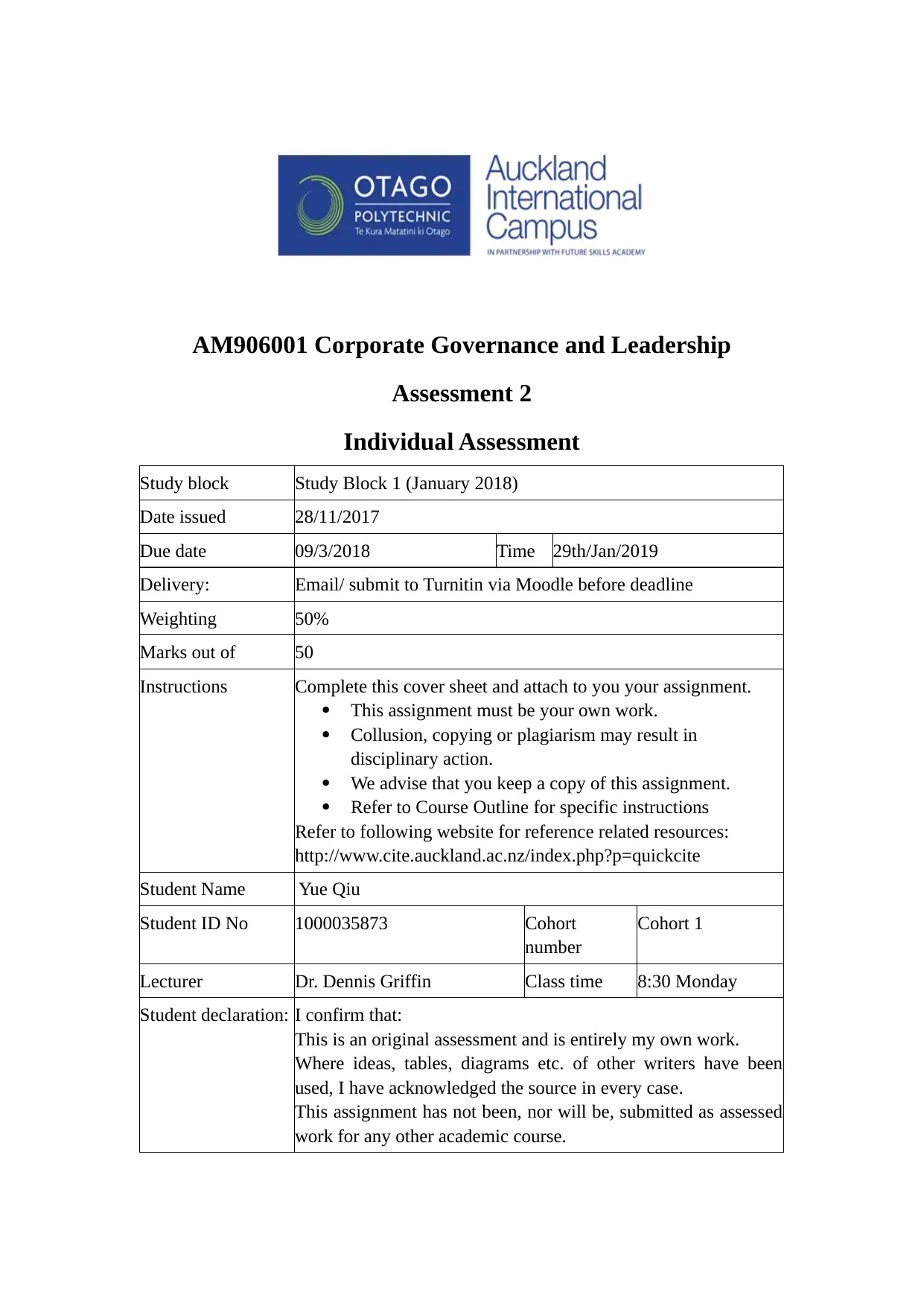
AM906001 Corporate Governance and Leadership
Assessment 2
Individual Assessment
Study block Study Block 1 (January 2018)
Date issued 28/11/2017
Due date 09/3/2018 Time 29th/Jan/2019
Delivery: Email/ submit to Turnitin via Moodle before deadline
Weighting 50%
Marks out of 50
Instructions Complete this cover sheet and attach to you your assignment.
This assignment must be your own work.
Collusion, copying or plagiarism may result in
disciplinary action.
We advise that you keep a copy of this assignment.
Refer to Course Outline for specific instructions
Refer to following website for reference related resources:
http://www.cite.auckland.ac.nz/index.php?p=quickcite
Student Name Yue Qiu
Student ID No 1000035873 Cohort
number
Cohort 1
Lecturer Dr. Dennis Griffin Class time 8:30 Monday
Student declaration: I confirm that:
This is an original assessment and is entirely my own work.
Where ideas, tables, diagrams etc. of other writers have been
used, I have acknowledged the source in every case.
This assignment has not been, nor will be, submitted as assessed
work for any other academic course.
Assessment 2
Individual Assessment
Study block Study Block 1 (January 2018)
Date issued 28/11/2017
Due date 09/3/2018 Time 29th/Jan/2019
Delivery: Email/ submit to Turnitin via Moodle before deadline
Weighting 50%
Marks out of 50
Instructions Complete this cover sheet and attach to you your assignment.
This assignment must be your own work.
Collusion, copying or plagiarism may result in
disciplinary action.
We advise that you keep a copy of this assignment.
Refer to Course Outline for specific instructions
Refer to following website for reference related resources:
http://www.cite.auckland.ac.nz/index.php?p=quickcite
Student Name Yue Qiu
Student ID No 1000035873 Cohort
number
Cohort 1
Lecturer Dr. Dennis Griffin Class time 8:30 Monday
Student declaration: I confirm that:
This is an original assessment and is entirely my own work.
Where ideas, tables, diagrams etc. of other writers have been
used, I have acknowledged the source in every case.
This assignment has not been, nor will be, submitted as assessed
work for any other academic course.
Paraphrase This Document
Need a fresh take? Get an instant paraphrase of this document with our AI Paraphraser
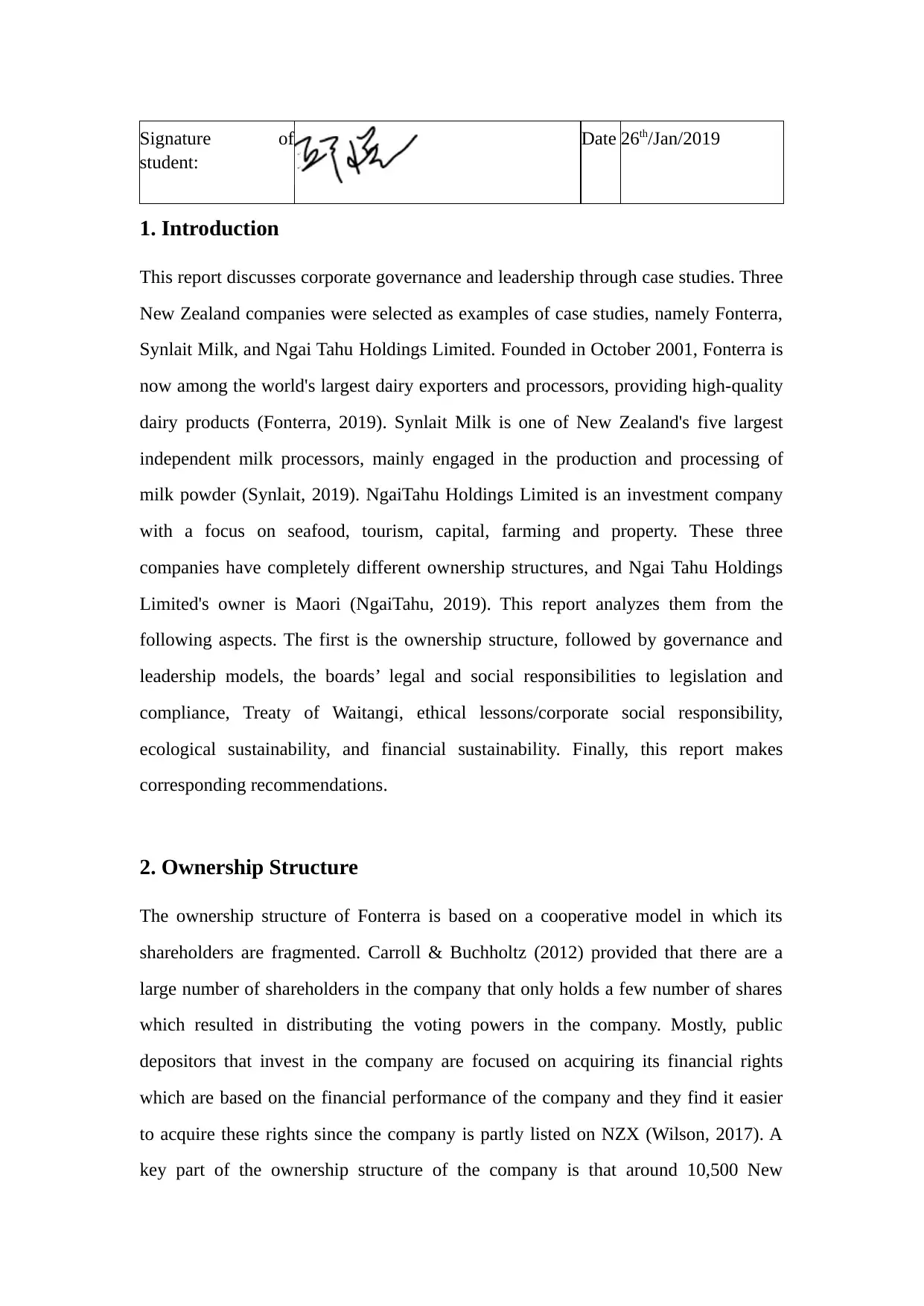
Signature of
student:
Date 26th/Jan/2019
1. Introduction
This report discusses corporate governance and leadership through case studies. Three
New Zealand companies were selected as examples of case studies, namely Fonterra,
Synlait Milk, and Ngai Tahu Holdings Limited. Founded in October 2001, Fonterra is
now among the world's largest dairy exporters and processors, providing high-quality
dairy products (Fonterra, 2019). Synlait Milk is one of New Zealand's five largest
independent milk processors, mainly engaged in the production and processing of
milk powder (Synlait, 2019). NgaiTahu Holdings Limited is an investment company
with a focus on seafood, tourism, capital, farming and property. These three
companies have completely different ownership structures, and Ngai Tahu Holdings
Limited's owner is Maori (NgaiTahu, 2019). This report analyzes them from the
following aspects. The first is the ownership structure, followed by governance and
leadership models, the boards’ legal and social responsibilities to legislation and
compliance, Treaty of Waitangi, ethical lessons/corporate social responsibility,
ecological sustainability, and financial sustainability. Finally, this report makes
corresponding recommendations.
2. Ownership Structure
The ownership structure of Fonterra is based on a cooperative model in which its
shareholders are fragmented. Carroll & Buchholtz (2012) provided that there are a
large number of shareholders in the company that only holds a few number of shares
which resulted in distributing the voting powers in the company. Mostly, public
depositors that invest in the company are focused on acquiring its financial rights
which are based on the financial performance of the company and they find it easier
to acquire these rights since the company is partly listed on NZX (Wilson, 2017). A
key part of the ownership structure of the company is that around 10,500 New
student:
Date 26th/Jan/2019
1. Introduction
This report discusses corporate governance and leadership through case studies. Three
New Zealand companies were selected as examples of case studies, namely Fonterra,
Synlait Milk, and Ngai Tahu Holdings Limited. Founded in October 2001, Fonterra is
now among the world's largest dairy exporters and processors, providing high-quality
dairy products (Fonterra, 2019). Synlait Milk is one of New Zealand's five largest
independent milk processors, mainly engaged in the production and processing of
milk powder (Synlait, 2019). NgaiTahu Holdings Limited is an investment company
with a focus on seafood, tourism, capital, farming and property. These three
companies have completely different ownership structures, and Ngai Tahu Holdings
Limited's owner is Maori (NgaiTahu, 2019). This report analyzes them from the
following aspects. The first is the ownership structure, followed by governance and
leadership models, the boards’ legal and social responsibilities to legislation and
compliance, Treaty of Waitangi, ethical lessons/corporate social responsibility,
ecological sustainability, and financial sustainability. Finally, this report makes
corresponding recommendations.
2. Ownership Structure
The ownership structure of Fonterra is based on a cooperative model in which its
shareholders are fragmented. Carroll & Buchholtz (2012) provided that there are a
large number of shareholders in the company that only holds a few number of shares
which resulted in distributing the voting powers in the company. Mostly, public
depositors that invest in the company are focused on acquiring its financial rights
which are based on the financial performance of the company and they find it easier
to acquire these rights since the company is partly listed on NZX (Wilson, 2017). A
key part of the ownership structure of the company is that around 10,500 New
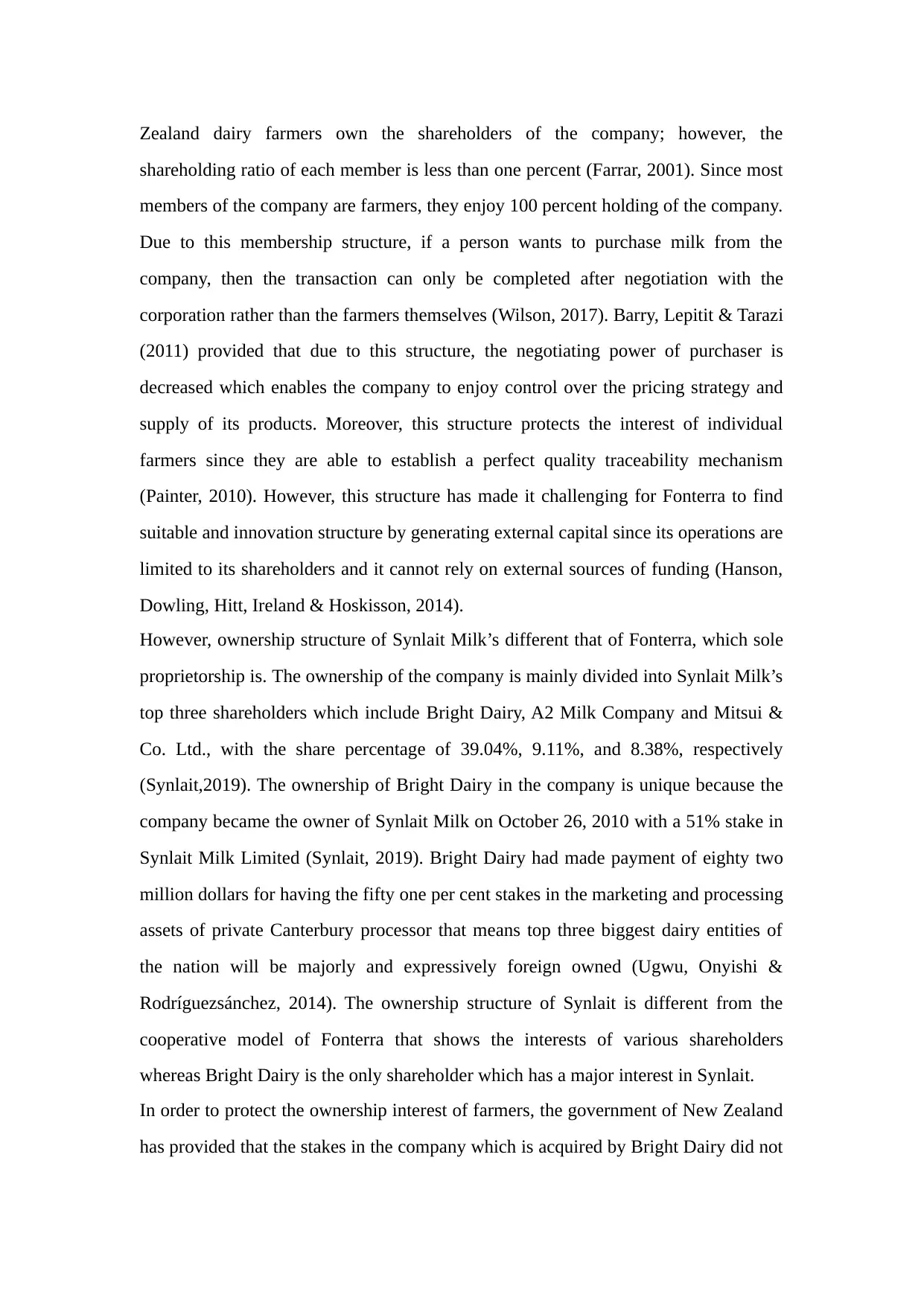
Zealand dairy farmers own the shareholders of the company; however, the
shareholding ratio of each member is less than one percent (Farrar, 2001). Since most
members of the company are farmers, they enjoy 100 percent holding of the company.
Due to this membership structure, if a person wants to purchase milk from the
company, then the transaction can only be completed after negotiation with the
corporation rather than the farmers themselves (Wilson, 2017). Barry, Lepitit & Tarazi
(2011) provided that due to this structure, the negotiating power of purchaser is
decreased which enables the company to enjoy control over the pricing strategy and
supply of its products. Moreover, this structure protects the interest of individual
farmers since they are able to establish a perfect quality traceability mechanism
(Painter, 2010). However, this structure has made it challenging for Fonterra to find
suitable and innovation structure by generating external capital since its operations are
limited to its shareholders and it cannot rely on external sources of funding (Hanson,
Dowling, Hitt, Ireland & Hoskisson, 2014).
However, ownership structure of Synlait Milk’s different that of Fonterra, which sole
proprietorship is. The ownership of the company is mainly divided into Synlait Milk’s
top three shareholders which include Bright Dairy, A2 Milk Company and Mitsui &
Co. Ltd., with the share percentage of 39.04%, 9.11%, and 8.38%, respectively
(Synlait,2019). The ownership of Bright Dairy in the company is unique because the
company became the owner of Synlait Milk on October 26, 2010 with a 51% stake in
Synlait Milk Limited (Synlait, 2019). Bright Dairy had made payment of eighty two
million dollars for having the fifty one per cent stakes in the marketing and processing
assets of private Canterbury processor that means top three biggest dairy entities of
the nation will be majorly and expressively foreign owned (Ugwu, Onyishi &
Rodríguezsánchez, 2014). The ownership structure of Synlait is different from the
cooperative model of Fonterra that shows the interests of various shareholders
whereas Bright Dairy is the only shareholder which has a major interest in Synlait.
In order to protect the ownership interest of farmers, the government of New Zealand
has provided that the stakes in the company which is acquired by Bright Dairy did not
shareholding ratio of each member is less than one percent (Farrar, 2001). Since most
members of the company are farmers, they enjoy 100 percent holding of the company.
Due to this membership structure, if a person wants to purchase milk from the
company, then the transaction can only be completed after negotiation with the
corporation rather than the farmers themselves (Wilson, 2017). Barry, Lepitit & Tarazi
(2011) provided that due to this structure, the negotiating power of purchaser is
decreased which enables the company to enjoy control over the pricing strategy and
supply of its products. Moreover, this structure protects the interest of individual
farmers since they are able to establish a perfect quality traceability mechanism
(Painter, 2010). However, this structure has made it challenging for Fonterra to find
suitable and innovation structure by generating external capital since its operations are
limited to its shareholders and it cannot rely on external sources of funding (Hanson,
Dowling, Hitt, Ireland & Hoskisson, 2014).
However, ownership structure of Synlait Milk’s different that of Fonterra, which sole
proprietorship is. The ownership of the company is mainly divided into Synlait Milk’s
top three shareholders which include Bright Dairy, A2 Milk Company and Mitsui &
Co. Ltd., with the share percentage of 39.04%, 9.11%, and 8.38%, respectively
(Synlait,2019). The ownership of Bright Dairy in the company is unique because the
company became the owner of Synlait Milk on October 26, 2010 with a 51% stake in
Synlait Milk Limited (Synlait, 2019). Bright Dairy had made payment of eighty two
million dollars for having the fifty one per cent stakes in the marketing and processing
assets of private Canterbury processor that means top three biggest dairy entities of
the nation will be majorly and expressively foreign owned (Ugwu, Onyishi &
Rodríguezsánchez, 2014). The ownership structure of Synlait is different from the
cooperative model of Fonterra that shows the interests of various shareholders
whereas Bright Dairy is the only shareholder which has a major interest in Synlait.
In order to protect the ownership interest of farmers, the government of New Zealand
has provided that the stakes in the company which is acquired by Bright Dairy did not
⊘ This is a preview!⊘
Do you want full access?
Subscribe today to unlock all pages.

Trusted by 1+ million students worldwide
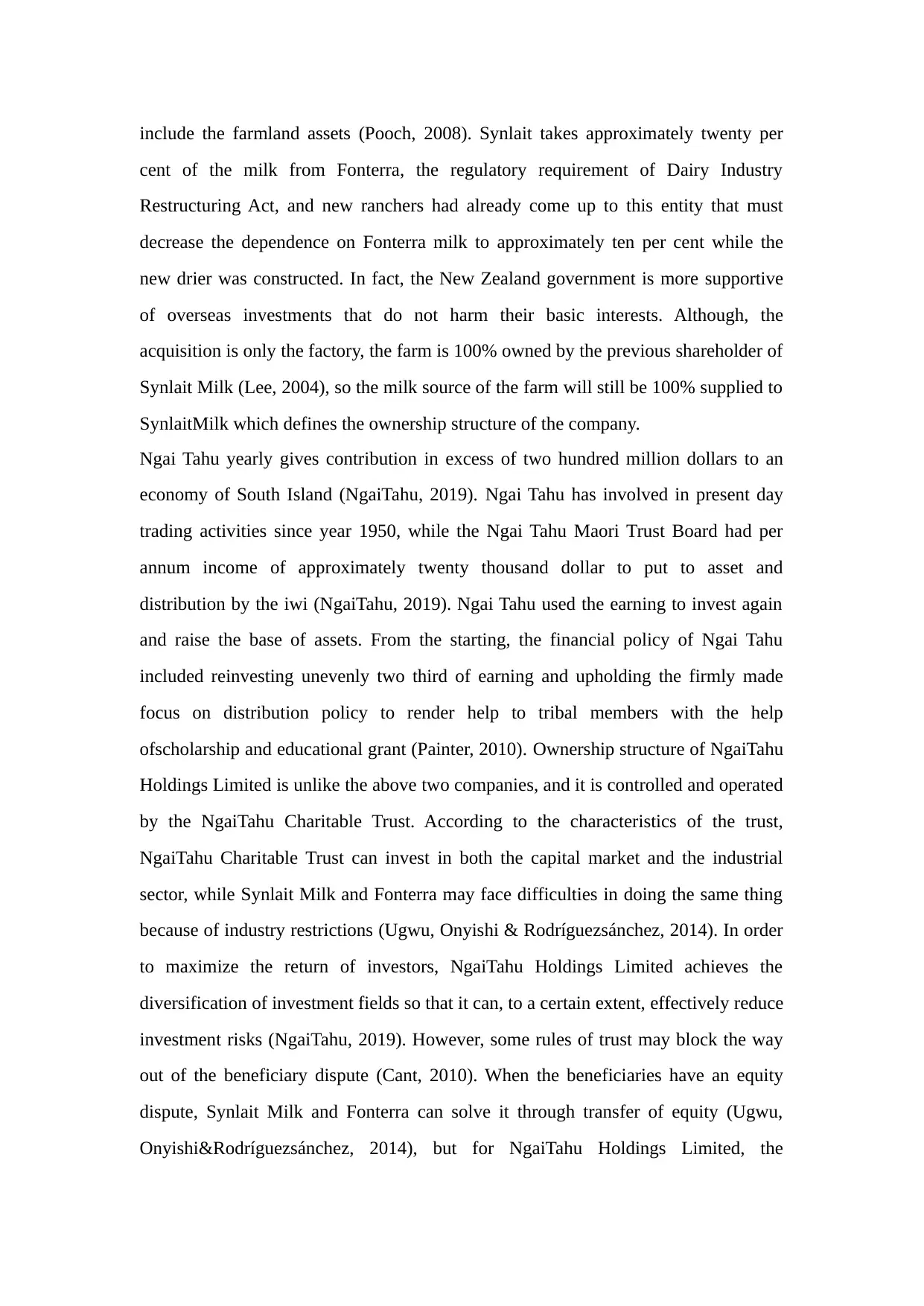
include the farmland assets (Pooch, 2008). Synlait takes approximately twenty per
cent of the milk from Fonterra, the regulatory requirement of Dairy Industry
Restructuring Act, and new ranchers had already come up to this entity that must
decrease the dependence on Fonterra milk to approximately ten per cent while the
new drier was constructed. In fact, the New Zealand government is more supportive
of overseas investments that do not harm their basic interests. Although, the
acquisition is only the factory, the farm is 100% owned by the previous shareholder of
Synlait Milk (Lee, 2004), so the milk source of the farm will still be 100% supplied to
SynlaitMilk which defines the ownership structure of the company.
Ngai Tahu yearly gives contribution in excess of two hundred million dollars to an
economy of South Island (NgaiTahu, 2019). Ngai Tahu has involved in present day
trading activities since year 1950, while the Ngai Tahu Maori Trust Board had per
annum income of approximately twenty thousand dollar to put to asset and
distribution by the iwi (NgaiTahu, 2019). Ngai Tahu used the earning to invest again
and raise the base of assets. From the starting, the financial policy of Ngai Tahu
included reinvesting unevenly two third of earning and upholding the firmly made
focus on distribution policy to render help to tribal members with the help
ofscholarship and educational grant (Painter, 2010). Ownership structure of NgaiTahu
Holdings Limited is unlike the above two companies, and it is controlled and operated
by the NgaiTahu Charitable Trust. According to the characteristics of the trust,
NgaiTahu Charitable Trust can invest in both the capital market and the industrial
sector, while Synlait Milk and Fonterra may face difficulties in doing the same thing
because of industry restrictions (Ugwu, Onyishi & Rodríguezsánchez, 2014). In order
to maximize the return of investors, NgaiTahu Holdings Limited achieves the
diversification of investment fields so that it can, to a certain extent, effectively reduce
investment risks (NgaiTahu, 2019). However, some rules of trust may block the way
out of the beneficiary dispute (Cant, 2010). When the beneficiaries have an equity
dispute, Synlait Milk and Fonterra can solve it through transfer of equity (Ugwu,
Onyishi&Rodríguezsánchez, 2014), but for NgaiTahu Holdings Limited, the
cent of the milk from Fonterra, the regulatory requirement of Dairy Industry
Restructuring Act, and new ranchers had already come up to this entity that must
decrease the dependence on Fonterra milk to approximately ten per cent while the
new drier was constructed. In fact, the New Zealand government is more supportive
of overseas investments that do not harm their basic interests. Although, the
acquisition is only the factory, the farm is 100% owned by the previous shareholder of
Synlait Milk (Lee, 2004), so the milk source of the farm will still be 100% supplied to
SynlaitMilk which defines the ownership structure of the company.
Ngai Tahu yearly gives contribution in excess of two hundred million dollars to an
economy of South Island (NgaiTahu, 2019). Ngai Tahu has involved in present day
trading activities since year 1950, while the Ngai Tahu Maori Trust Board had per
annum income of approximately twenty thousand dollar to put to asset and
distribution by the iwi (NgaiTahu, 2019). Ngai Tahu used the earning to invest again
and raise the base of assets. From the starting, the financial policy of Ngai Tahu
included reinvesting unevenly two third of earning and upholding the firmly made
focus on distribution policy to render help to tribal members with the help
ofscholarship and educational grant (Painter, 2010). Ownership structure of NgaiTahu
Holdings Limited is unlike the above two companies, and it is controlled and operated
by the NgaiTahu Charitable Trust. According to the characteristics of the trust,
NgaiTahu Charitable Trust can invest in both the capital market and the industrial
sector, while Synlait Milk and Fonterra may face difficulties in doing the same thing
because of industry restrictions (Ugwu, Onyishi & Rodríguezsánchez, 2014). In order
to maximize the return of investors, NgaiTahu Holdings Limited achieves the
diversification of investment fields so that it can, to a certain extent, effectively reduce
investment risks (NgaiTahu, 2019). However, some rules of trust may block the way
out of the beneficiary dispute (Cant, 2010). When the beneficiaries have an equity
dispute, Synlait Milk and Fonterra can solve it through transfer of equity (Ugwu,
Onyishi&Rodríguezsánchez, 2014), but for NgaiTahu Holdings Limited, the
Paraphrase This Document
Need a fresh take? Get an instant paraphrase of this document with our AI Paraphraser
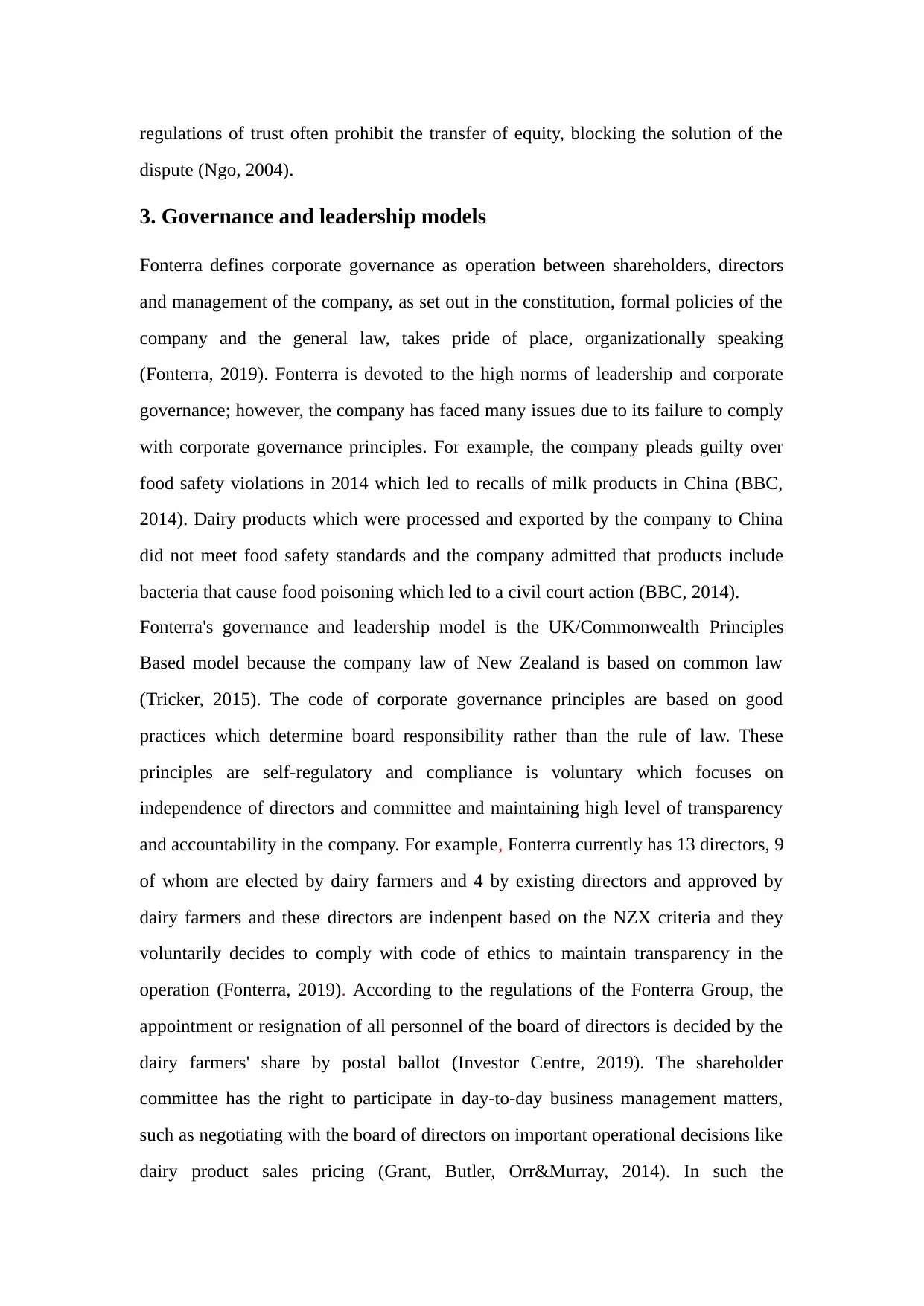
regulations of trust often prohibit the transfer of equity, blocking the solution of the
dispute (Ngo, 2004).
3. Governance and leadership models
Fonterra defines corporate governance as operation between shareholders, directors
and management of the company, as set out in the constitution, formal policies of the
company and the general law, takes pride of place, organizationally speaking
(Fonterra, 2019). Fonterra is devoted to the high norms of leadership and corporate
governance; however, the company has faced many issues due to its failure to comply
with corporate governance principles. For example, the company pleads guilty over
food safety violations in 2014 which led to recalls of milk products in China (BBC,
2014). Dairy products which were processed and exported by the company to China
did not meet food safety standards and the company admitted that products include
bacteria that cause food poisoning which led to a civil court action (BBC, 2014).
Fonterra's governance and leadership model is the UK/Commonwealth Principles
Based model because the company law of New Zealand is based on common law
(Tricker, 2015). The code of corporate governance principles are based on good
practices which determine board responsibility rather than the rule of law. These
principles are self-regulatory and compliance is voluntary which focuses on
independence of directors and committee and maintaining high level of transparency
and accountability in the company. For example, Fonterra currently has 13 directors, 9
of whom are elected by dairy farmers and 4 by existing directors and approved by
dairy farmers and these directors are indenpent based on the NZX criteria and they
voluntarily decides to comply with code of ethics to maintain transparency in the
operation (Fonterra, 2019). According to the regulations of the Fonterra Group, the
appointment or resignation of all personnel of the board of directors is decided by the
dairy farmers' share by postal ballot (Investor Centre, 2019). The shareholder
committee has the right to participate in day-to-day business management matters,
such as negotiating with the board of directors on important operational decisions like
dairy product sales pricing (Grant, Butler, Orr&Murray, 2014). In such the
dispute (Ngo, 2004).
3. Governance and leadership models
Fonterra defines corporate governance as operation between shareholders, directors
and management of the company, as set out in the constitution, formal policies of the
company and the general law, takes pride of place, organizationally speaking
(Fonterra, 2019). Fonterra is devoted to the high norms of leadership and corporate
governance; however, the company has faced many issues due to its failure to comply
with corporate governance principles. For example, the company pleads guilty over
food safety violations in 2014 which led to recalls of milk products in China (BBC,
2014). Dairy products which were processed and exported by the company to China
did not meet food safety standards and the company admitted that products include
bacteria that cause food poisoning which led to a civil court action (BBC, 2014).
Fonterra's governance and leadership model is the UK/Commonwealth Principles
Based model because the company law of New Zealand is based on common law
(Tricker, 2015). The code of corporate governance principles are based on good
practices which determine board responsibility rather than the rule of law. These
principles are self-regulatory and compliance is voluntary which focuses on
independence of directors and committee and maintaining high level of transparency
and accountability in the company. For example, Fonterra currently has 13 directors, 9
of whom are elected by dairy farmers and 4 by existing directors and approved by
dairy farmers and these directors are indenpent based on the NZX criteria and they
voluntarily decides to comply with code of ethics to maintain transparency in the
operation (Fonterra, 2019). According to the regulations of the Fonterra Group, the
appointment or resignation of all personnel of the board of directors is decided by the
dairy farmers' share by postal ballot (Investor Centre, 2019). The shareholder
committee has the right to participate in day-to-day business management matters,
such as negotiating with the board of directors on important operational decisions like
dairy product sales pricing (Grant, Butler, Orr&Murray, 2014). In such the
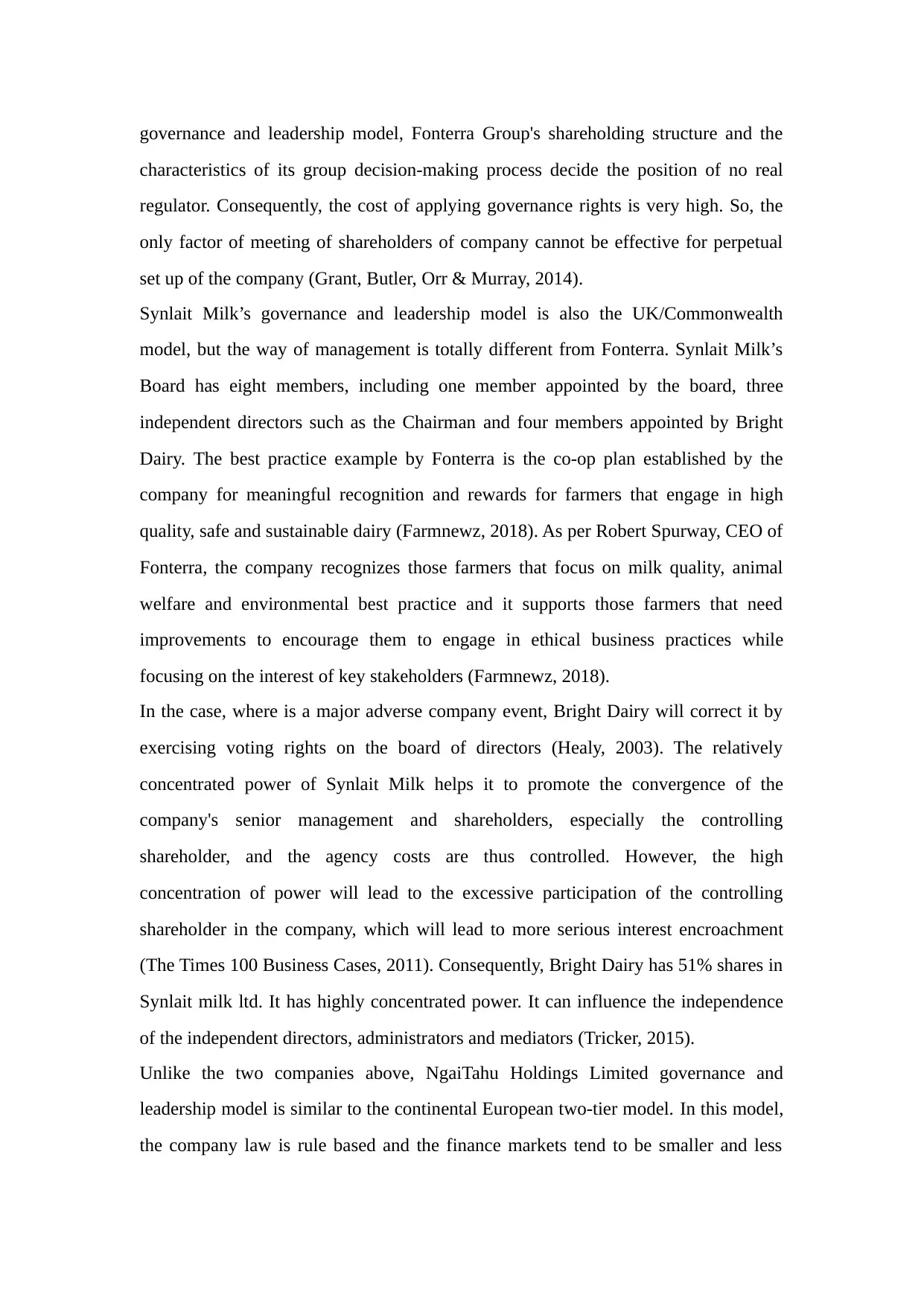
governance and leadership model, Fonterra Group's shareholding structure and the
characteristics of its group decision-making process decide the position of no real
regulator. Consequently, the cost of applying governance rights is very high. So, the
only factor of meeting of shareholders of company cannot be effective for perpetual
set up of the company (Grant, Butler, Orr & Murray, 2014).
Synlait Milk’s governance and leadership model is also the UK/Commonwealth
model, but the way of management is totally different from Fonterra. Synlait Milk’s
Board has eight members, including one member appointed by the board, three
independent directors such as the Chairman and four members appointed by Bright
Dairy. The best practice example by Fonterra is the co-op plan established by the
company for meaningful recognition and rewards for farmers that engage in high
quality, safe and sustainable dairy (Farmnewz, 2018). As per Robert Spurway, CEO of
Fonterra, the company recognizes those farmers that focus on milk quality, animal
welfare and environmental best practice and it supports those farmers that need
improvements to encourage them to engage in ethical business practices while
focusing on the interest of key stakeholders (Farmnewz, 2018).
In the case, where is a major adverse company event, Bright Dairy will correct it by
exercising voting rights on the board of directors (Healy, 2003). The relatively
concentrated power of Synlait Milk helps it to promote the convergence of the
company's senior management and shareholders, especially the controlling
shareholder, and the agency costs are thus controlled. However, the high
concentration of power will lead to the excessive participation of the controlling
shareholder in the company, which will lead to more serious interest encroachment
(The Times 100 Business Cases, 2011). Consequently, Bright Dairy has 51% shares in
Synlait milk ltd. It has highly concentrated power. It can influence the independence
of the independent directors, administrators and mediators (Tricker, 2015).
Unlike the two companies above, NgaiTahu Holdings Limited governance and
leadership model is similar to the continental European two-tier model. In this model,
the company law is rule based and the finance markets tend to be smaller and less
characteristics of its group decision-making process decide the position of no real
regulator. Consequently, the cost of applying governance rights is very high. So, the
only factor of meeting of shareholders of company cannot be effective for perpetual
set up of the company (Grant, Butler, Orr & Murray, 2014).
Synlait Milk’s governance and leadership model is also the UK/Commonwealth
model, but the way of management is totally different from Fonterra. Synlait Milk’s
Board has eight members, including one member appointed by the board, three
independent directors such as the Chairman and four members appointed by Bright
Dairy. The best practice example by Fonterra is the co-op plan established by the
company for meaningful recognition and rewards for farmers that engage in high
quality, safe and sustainable dairy (Farmnewz, 2018). As per Robert Spurway, CEO of
Fonterra, the company recognizes those farmers that focus on milk quality, animal
welfare and environmental best practice and it supports those farmers that need
improvements to encourage them to engage in ethical business practices while
focusing on the interest of key stakeholders (Farmnewz, 2018).
In the case, where is a major adverse company event, Bright Dairy will correct it by
exercising voting rights on the board of directors (Healy, 2003). The relatively
concentrated power of Synlait Milk helps it to promote the convergence of the
company's senior management and shareholders, especially the controlling
shareholder, and the agency costs are thus controlled. However, the high
concentration of power will lead to the excessive participation of the controlling
shareholder in the company, which will lead to more serious interest encroachment
(The Times 100 Business Cases, 2011). Consequently, Bright Dairy has 51% shares in
Synlait milk ltd. It has highly concentrated power. It can influence the independence
of the independent directors, administrators and mediators (Tricker, 2015).
Unlike the two companies above, NgaiTahu Holdings Limited governance and
leadership model is similar to the continental European two-tier model. In this model,
the company law is rule based and the finance markets tend to be smaller and less
⊘ This is a preview!⊘
Do you want full access?
Subscribe today to unlock all pages.

Trusted by 1+ million students worldwide
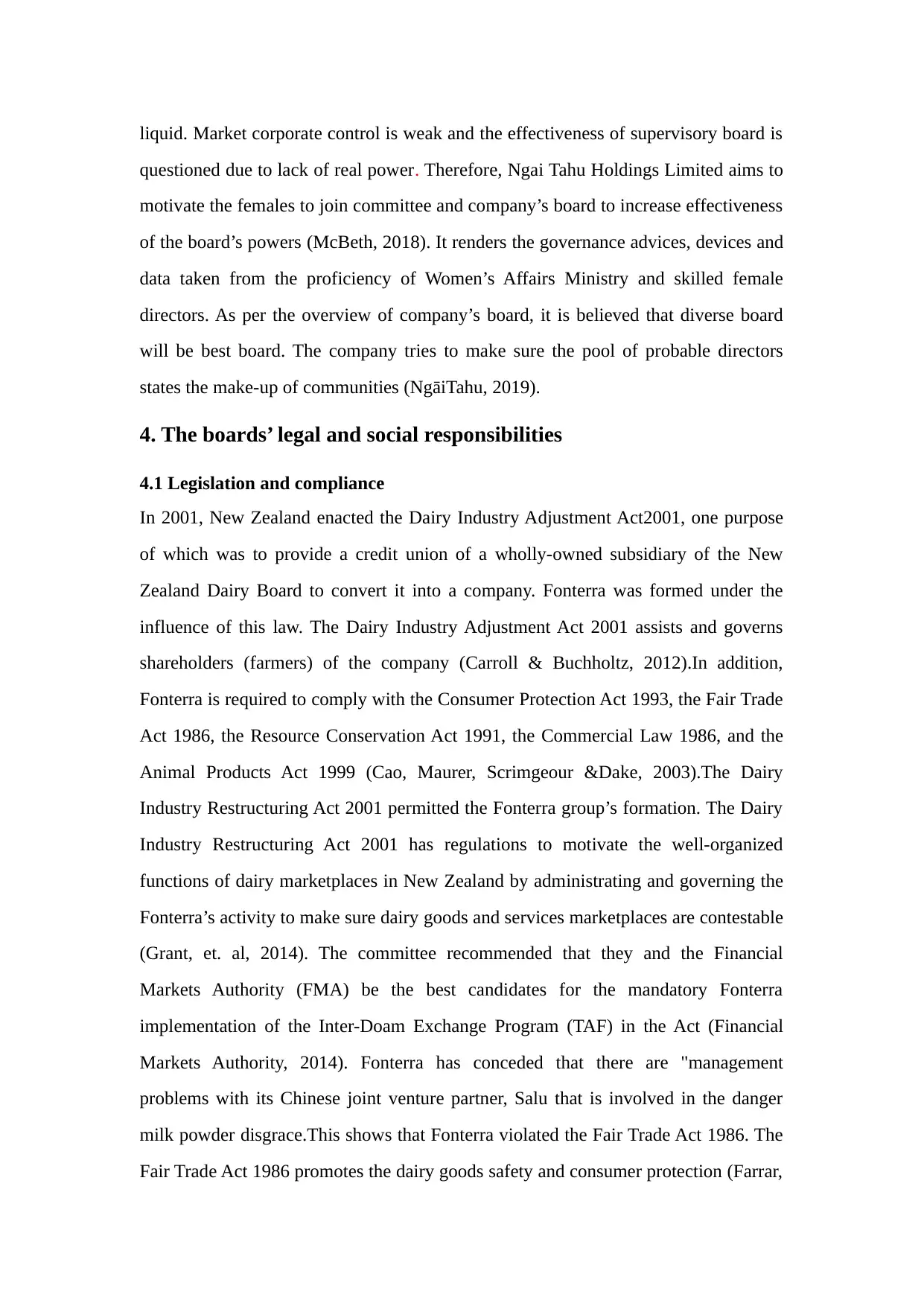
liquid. Market corporate control is weak and the effectiveness of supervisory board is
questioned due to lack of real power. Therefore, Ngai Tahu Holdings Limited aims to
motivate the females to join committee and company’s board to increase effectiveness
of the board’s powers (McBeth, 2018). It renders the governance advices, devices and
data taken from the proficiency of Women’s Affairs Ministry and skilled female
directors. As per the overview of company’s board, it is believed that diverse board
will be best board. The company tries to make sure the pool of probable directors
states the make-up of communities (NgāiTahu, 2019).
4. The boards’ legal and social responsibilities
4.1 Legislation and compliance
In 2001, New Zealand enacted the Dairy Industry Adjustment Act2001, one purpose
of which was to provide a credit union of a wholly-owned subsidiary of the New
Zealand Dairy Board to convert it into a company. Fonterra was formed under the
influence of this law. The Dairy Industry Adjustment Act 2001 assists and governs
shareholders (farmers) of the company (Carroll & Buchholtz, 2012).In addition,
Fonterra is required to comply with the Consumer Protection Act 1993, the Fair Trade
Act 1986, the Resource Conservation Act 1991, the Commercial Law 1986, and the
Animal Products Act 1999 (Cao, Maurer, Scrimgeour &Dake, 2003).The Dairy
Industry Restructuring Act 2001 permitted the Fonterra group’s formation. The Dairy
Industry Restructuring Act 2001 has regulations to motivate the well-organized
functions of dairy marketplaces in New Zealand by administrating and governing the
Fonterra’s activity to make sure dairy goods and services marketplaces are contestable
(Grant, et. al, 2014). The committee recommended that they and the Financial
Markets Authority (FMA) be the best candidates for the mandatory Fonterra
implementation of the Inter-Doam Exchange Program (TAF) in the Act (Financial
Markets Authority, 2014). Fonterra has conceded that there are "management
problems with its Chinese joint venture partner, Salu that is involved in the danger
milk powder disgrace.This shows that Fonterra violated the Fair Trade Act 1986. The
Fair Trade Act 1986 promotes the dairy goods safety and consumer protection (Farrar,
questioned due to lack of real power. Therefore, Ngai Tahu Holdings Limited aims to
motivate the females to join committee and company’s board to increase effectiveness
of the board’s powers (McBeth, 2018). It renders the governance advices, devices and
data taken from the proficiency of Women’s Affairs Ministry and skilled female
directors. As per the overview of company’s board, it is believed that diverse board
will be best board. The company tries to make sure the pool of probable directors
states the make-up of communities (NgāiTahu, 2019).
4. The boards’ legal and social responsibilities
4.1 Legislation and compliance
In 2001, New Zealand enacted the Dairy Industry Adjustment Act2001, one purpose
of which was to provide a credit union of a wholly-owned subsidiary of the New
Zealand Dairy Board to convert it into a company. Fonterra was formed under the
influence of this law. The Dairy Industry Adjustment Act 2001 assists and governs
shareholders (farmers) of the company (Carroll & Buchholtz, 2012).In addition,
Fonterra is required to comply with the Consumer Protection Act 1993, the Fair Trade
Act 1986, the Resource Conservation Act 1991, the Commercial Law 1986, and the
Animal Products Act 1999 (Cao, Maurer, Scrimgeour &Dake, 2003).The Dairy
Industry Restructuring Act 2001 permitted the Fonterra group’s formation. The Dairy
Industry Restructuring Act 2001 has regulations to motivate the well-organized
functions of dairy marketplaces in New Zealand by administrating and governing the
Fonterra’s activity to make sure dairy goods and services marketplaces are contestable
(Grant, et. al, 2014). The committee recommended that they and the Financial
Markets Authority (FMA) be the best candidates for the mandatory Fonterra
implementation of the Inter-Doam Exchange Program (TAF) in the Act (Financial
Markets Authority, 2014). Fonterra has conceded that there are "management
problems with its Chinese joint venture partner, Salu that is involved in the danger
milk powder disgrace.This shows that Fonterra violated the Fair Trade Act 1986. The
Fair Trade Act 1986 promotes the dairy goods safety and consumer protection (Farrar,
Paraphrase This Document
Need a fresh take? Get an instant paraphrase of this document with our AI Paraphraser
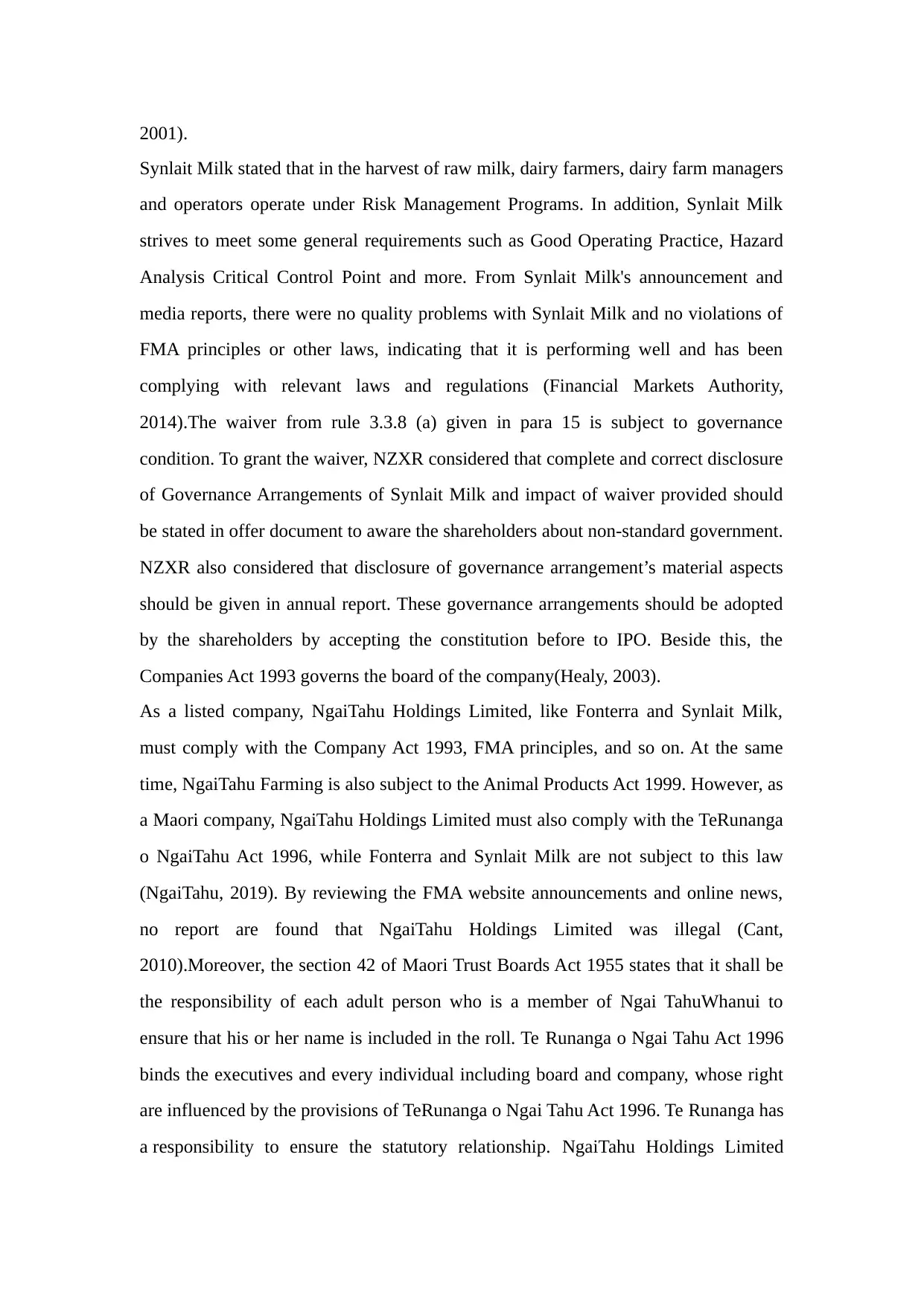
2001).
Synlait Milk stated that in the harvest of raw milk, dairy farmers, dairy farm managers
and operators operate under Risk Management Programs. In addition, Synlait Milk
strives to meet some general requirements such as Good Operating Practice, Hazard
Analysis Critical Control Point and more. From Synlait Milk's announcement and
media reports, there were no quality problems with Synlait Milk and no violations of
FMA principles or other laws, indicating that it is performing well and has been
complying with relevant laws and regulations (Financial Markets Authority,
2014).The waiver from rule 3.3.8 (a) given in para 15 is subject to governance
condition. To grant the waiver, NZXR considered that complete and correct disclosure
of Governance Arrangements of Synlait Milk and impact of waiver provided should
be stated in offer document to aware the shareholders about non-standard government.
NZXR also considered that disclosure of governance arrangement’s material aspects
should be given in annual report. These governance arrangements should be adopted
by the shareholders by accepting the constitution before to IPO. Beside this, the
Companies Act 1993 governs the board of the company(Healy, 2003).
As a listed company, NgaiTahu Holdings Limited, like Fonterra and Synlait Milk,
must comply with the Company Act 1993, FMA principles, and so on. At the same
time, NgaiTahu Farming is also subject to the Animal Products Act 1999. However, as
a Maori company, NgaiTahu Holdings Limited must also comply with the TeRunanga
o NgaiTahu Act 1996, while Fonterra and Synlait Milk are not subject to this law
(NgaiTahu, 2019). By reviewing the FMA website announcements and online news,
no report are found that NgaiTahu Holdings Limited was illegal (Cant,
2010).Moreover, the section 42 of Maori Trust Boards Act 1955 states that it shall be
the responsibility of each adult person who is a member of Ngai TahuWhanui to
ensure that his or her name is included in the roll. Te Runanga o Ngai Tahu Act 1996
binds the executives and every individual including board and company, whose right
are influenced by the provisions of TeRunanga o Ngai Tahu Act 1996. Te Runanga has
a responsibility to ensure the statutory relationship. NgaiTahu Holdings Limited
Synlait Milk stated that in the harvest of raw milk, dairy farmers, dairy farm managers
and operators operate under Risk Management Programs. In addition, Synlait Milk
strives to meet some general requirements such as Good Operating Practice, Hazard
Analysis Critical Control Point and more. From Synlait Milk's announcement and
media reports, there were no quality problems with Synlait Milk and no violations of
FMA principles or other laws, indicating that it is performing well and has been
complying with relevant laws and regulations (Financial Markets Authority,
2014).The waiver from rule 3.3.8 (a) given in para 15 is subject to governance
condition. To grant the waiver, NZXR considered that complete and correct disclosure
of Governance Arrangements of Synlait Milk and impact of waiver provided should
be stated in offer document to aware the shareholders about non-standard government.
NZXR also considered that disclosure of governance arrangement’s material aspects
should be given in annual report. These governance arrangements should be adopted
by the shareholders by accepting the constitution before to IPO. Beside this, the
Companies Act 1993 governs the board of the company(Healy, 2003).
As a listed company, NgaiTahu Holdings Limited, like Fonterra and Synlait Milk,
must comply with the Company Act 1993, FMA principles, and so on. At the same
time, NgaiTahu Farming is also subject to the Animal Products Act 1999. However, as
a Maori company, NgaiTahu Holdings Limited must also comply with the TeRunanga
o NgaiTahu Act 1996, while Fonterra and Synlait Milk are not subject to this law
(NgaiTahu, 2019). By reviewing the FMA website announcements and online news,
no report are found that NgaiTahu Holdings Limited was illegal (Cant,
2010).Moreover, the section 42 of Maori Trust Boards Act 1955 states that it shall be
the responsibility of each adult person who is a member of Ngai TahuWhanui to
ensure that his or her name is included in the roll. Te Runanga o Ngai Tahu Act 1996
binds the executives and every individual including board and company, whose right
are influenced by the provisions of TeRunanga o Ngai Tahu Act 1996. Te Runanga has
a responsibility to ensure the statutory relationship. NgaiTahu Holdings Limited
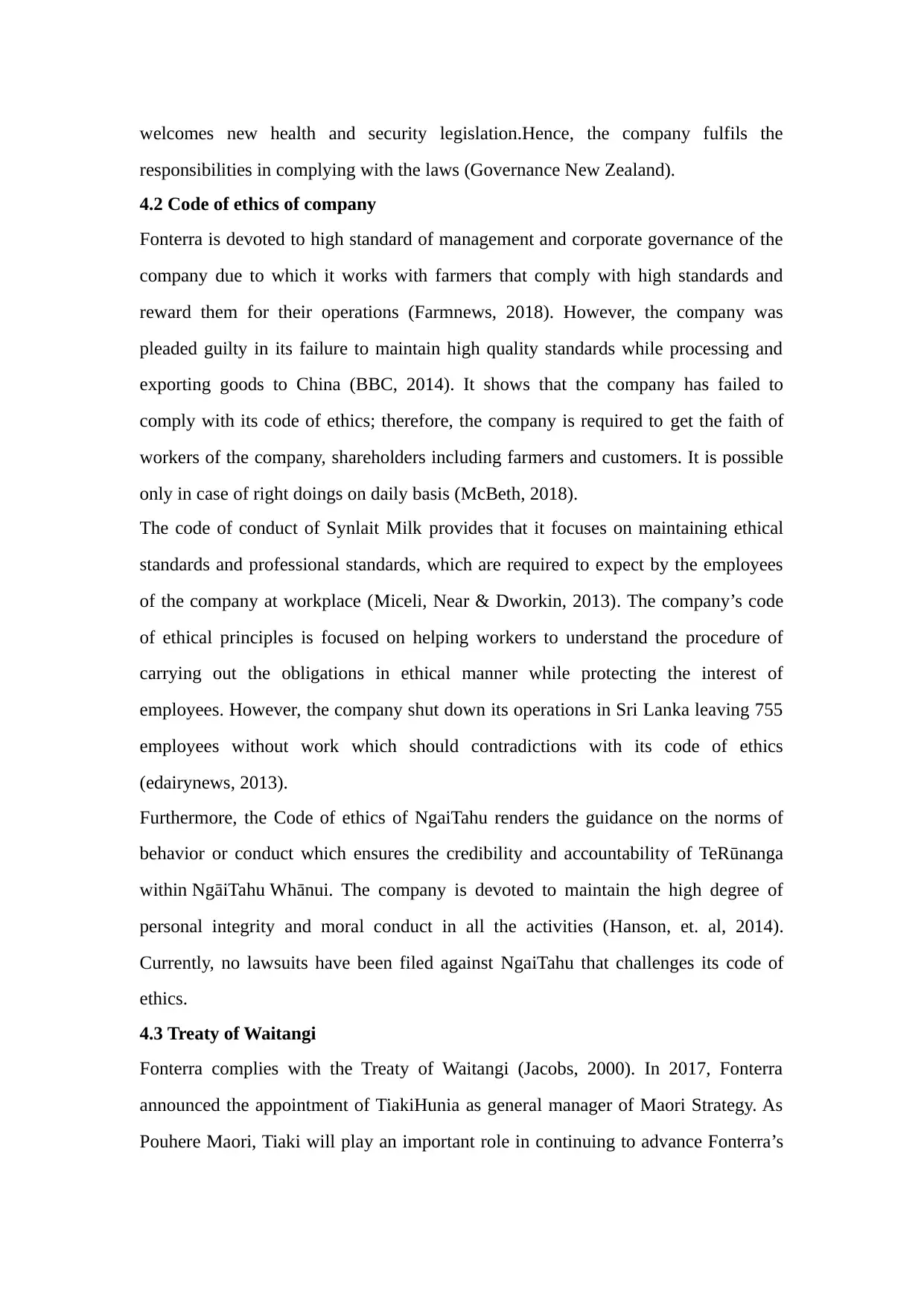
welcomes new health and security legislation.Hence, the company fulfils the
responsibilities in complying with the laws (Governance New Zealand).
4.2 Code of ethics of company
Fonterra is devoted to high standard of management and corporate governance of the
company due to which it works with farmers that comply with high standards and
reward them for their operations (Farmnews, 2018). However, the company was
pleaded guilty in its failure to maintain high quality standards while processing and
exporting goods to China (BBC, 2014). It shows that the company has failed to
comply with its code of ethics; therefore, the company is required to get the faith of
workers of the company, shareholders including farmers and customers. It is possible
only in case of right doings on daily basis (McBeth, 2018).
The code of conduct of Synlait Milk provides that it focuses on maintaining ethical
standards and professional standards, which are required to expect by the employees
of the company at workplace (Miceli, Near & Dworkin, 2013). The company’s code
of ethical principles is focused on helping workers to understand the procedure of
carrying out the obligations in ethical manner while protecting the interest of
employees. However, the company shut down its operations in Sri Lanka leaving 755
employees without work which should contradictions with its code of ethics
(edairynews, 2013).
Furthermore, the Code of ethics of NgaiTahu renders the guidance on the norms of
behavior or conduct which ensures the credibility and accountability of TeRūnanga
within NgāiTahu Whānui. The company is devoted to maintain the high degree of
personal integrity and moral conduct in all the activities (Hanson, et. al, 2014).
Currently, no lawsuits have been filed against NgaiTahu that challenges its code of
ethics.
4.3 Treaty of Waitangi
Fonterra complies with the Treaty of Waitangi (Jacobs, 2000). In 2017, Fonterra
announced the appointment of TiakiHunia as general manager of Maori Strategy. As
Pouhere Maori, Tiaki will play an important role in continuing to advance Fonterra’s
responsibilities in complying with the laws (Governance New Zealand).
4.2 Code of ethics of company
Fonterra is devoted to high standard of management and corporate governance of the
company due to which it works with farmers that comply with high standards and
reward them for their operations (Farmnews, 2018). However, the company was
pleaded guilty in its failure to maintain high quality standards while processing and
exporting goods to China (BBC, 2014). It shows that the company has failed to
comply with its code of ethics; therefore, the company is required to get the faith of
workers of the company, shareholders including farmers and customers. It is possible
only in case of right doings on daily basis (McBeth, 2018).
The code of conduct of Synlait Milk provides that it focuses on maintaining ethical
standards and professional standards, which are required to expect by the employees
of the company at workplace (Miceli, Near & Dworkin, 2013). The company’s code
of ethical principles is focused on helping workers to understand the procedure of
carrying out the obligations in ethical manner while protecting the interest of
employees. However, the company shut down its operations in Sri Lanka leaving 755
employees without work which should contradictions with its code of ethics
(edairynews, 2013).
Furthermore, the Code of ethics of NgaiTahu renders the guidance on the norms of
behavior or conduct which ensures the credibility and accountability of TeRūnanga
within NgāiTahu Whānui. The company is devoted to maintain the high degree of
personal integrity and moral conduct in all the activities (Hanson, et. al, 2014).
Currently, no lawsuits have been filed against NgaiTahu that challenges its code of
ethics.
4.3 Treaty of Waitangi
Fonterra complies with the Treaty of Waitangi (Jacobs, 2000). In 2017, Fonterra
announced the appointment of TiakiHunia as general manager of Maori Strategy. As
Pouhere Maori, Tiaki will play an important role in continuing to advance Fonterra’s
⊘ This is a preview!⊘
Do you want full access?
Subscribe today to unlock all pages.

Trusted by 1+ million students worldwide
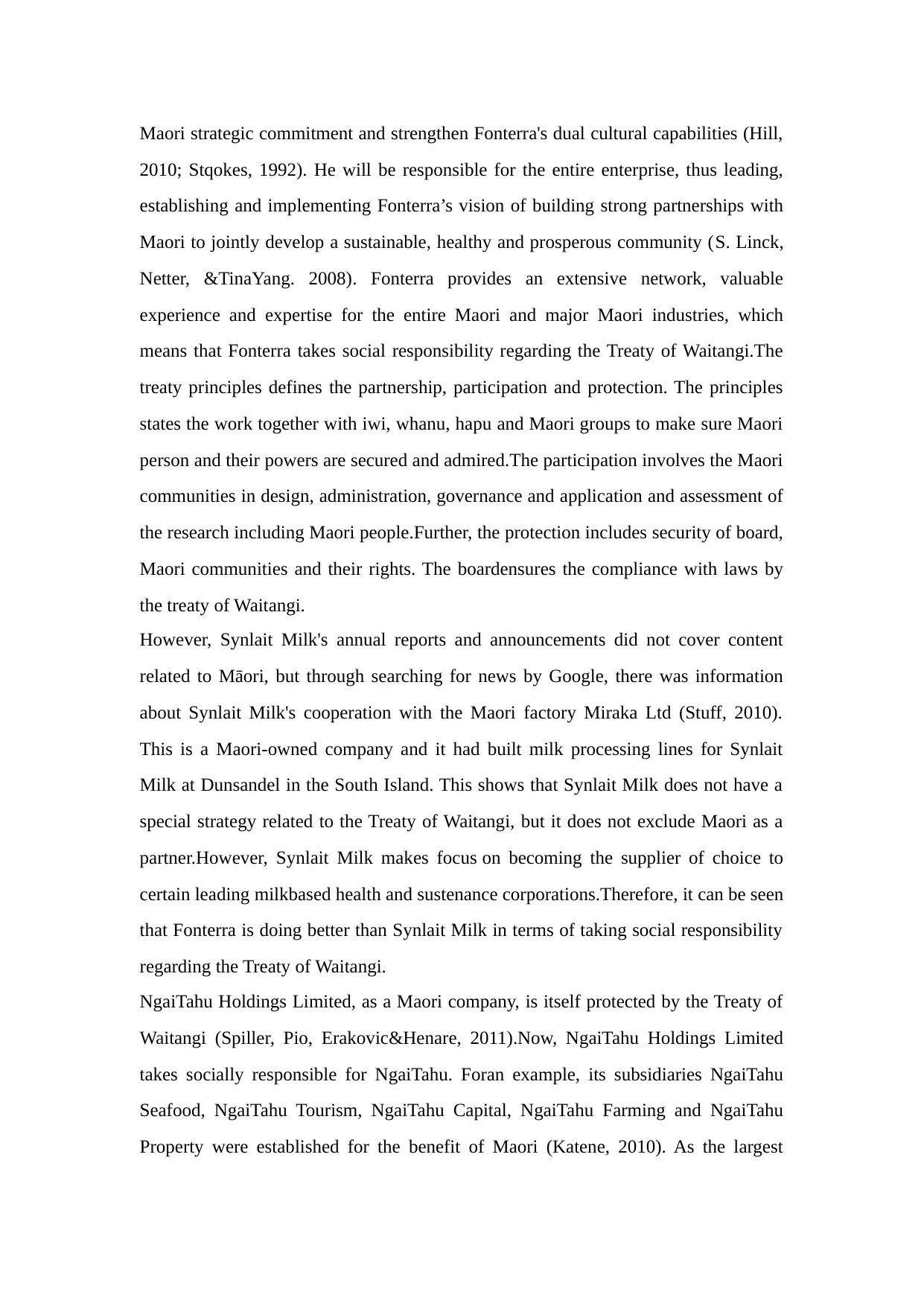
Maori strategic commitment and strengthen Fonterra's dual cultural capabilities (Hill,
2010; Stqokes, 1992). He will be responsible for the entire enterprise, thus leading,
establishing and implementing Fonterra’s vision of building strong partnerships with
Maori to jointly develop a sustainable, healthy and prosperous community (S. Linck,
Netter, &TinaYang. 2008). Fonterra provides an extensive network, valuable
experience and expertise for the entire Maori and major Maori industries, which
means that Fonterra takes social responsibility regarding the Treaty of Waitangi.The
treaty principles defines the partnership, participation and protection. The principles
states the work together with iwi, whanu, hapu and Maori groups to make sure Maori
person and their powers are secured and admired.The participation involves the Maori
communities in design, administration, governance and application and assessment of
the research including Maori people.Further, the protection includes security of board,
Maori communities and their rights. The boardensures the compliance with laws by
the treaty of Waitangi.
However, Synlait Milk's annual reports and announcements did not cover content
related to Māori, but through searching for news by Google, there was information
about Synlait Milk's cooperation with the Maori factory Miraka Ltd (Stuff, 2010).
This is a Maori-owned company and it had built milk processing lines for Synlait
Milk at Dunsandel in the South Island. This shows that Synlait Milk does not have a
special strategy related to the Treaty of Waitangi, but it does not exclude Maori as a
partner.However, Synlait Milk makes focus on becoming the supplier of choice to
certain leading milkbased health and sustenance corporations.Therefore, it can be seen
that Fonterra is doing better than Synlait Milk in terms of taking social responsibility
regarding the Treaty of Waitangi.
NgaiTahu Holdings Limited, as a Maori company, is itself protected by the Treaty of
Waitangi (Spiller, Pio, Erakovic&Henare, 2011).Now, NgaiTahu Holdings Limited
takes socially responsible for NgaiTahu. Foran example, its subsidiaries NgaiTahu
Seafood, NgaiTahu Tourism, NgaiTahu Capital, NgaiTahu Farming and NgaiTahu
Property were established for the benefit of Maori (Katene, 2010). As the largest
2010; Stqokes, 1992). He will be responsible for the entire enterprise, thus leading,
establishing and implementing Fonterra’s vision of building strong partnerships with
Maori to jointly develop a sustainable, healthy and prosperous community (S. Linck,
Netter, &TinaYang. 2008). Fonterra provides an extensive network, valuable
experience and expertise for the entire Maori and major Maori industries, which
means that Fonterra takes social responsibility regarding the Treaty of Waitangi.The
treaty principles defines the partnership, participation and protection. The principles
states the work together with iwi, whanu, hapu and Maori groups to make sure Maori
person and their powers are secured and admired.The participation involves the Maori
communities in design, administration, governance and application and assessment of
the research including Maori people.Further, the protection includes security of board,
Maori communities and their rights. The boardensures the compliance with laws by
the treaty of Waitangi.
However, Synlait Milk's annual reports and announcements did not cover content
related to Māori, but through searching for news by Google, there was information
about Synlait Milk's cooperation with the Maori factory Miraka Ltd (Stuff, 2010).
This is a Maori-owned company and it had built milk processing lines for Synlait
Milk at Dunsandel in the South Island. This shows that Synlait Milk does not have a
special strategy related to the Treaty of Waitangi, but it does not exclude Maori as a
partner.However, Synlait Milk makes focus on becoming the supplier of choice to
certain leading milkbased health and sustenance corporations.Therefore, it can be seen
that Fonterra is doing better than Synlait Milk in terms of taking social responsibility
regarding the Treaty of Waitangi.
NgaiTahu Holdings Limited, as a Maori company, is itself protected by the Treaty of
Waitangi (Spiller, Pio, Erakovic&Henare, 2011).Now, NgaiTahu Holdings Limited
takes socially responsible for NgaiTahu. Foran example, its subsidiaries NgaiTahu
Seafood, NgaiTahu Tourism, NgaiTahu Capital, NgaiTahu Farming and NgaiTahu
Property were established for the benefit of Maori (Katene, 2010). As the largest
Paraphrase This Document
Need a fresh take? Get an instant paraphrase of this document with our AI Paraphraser
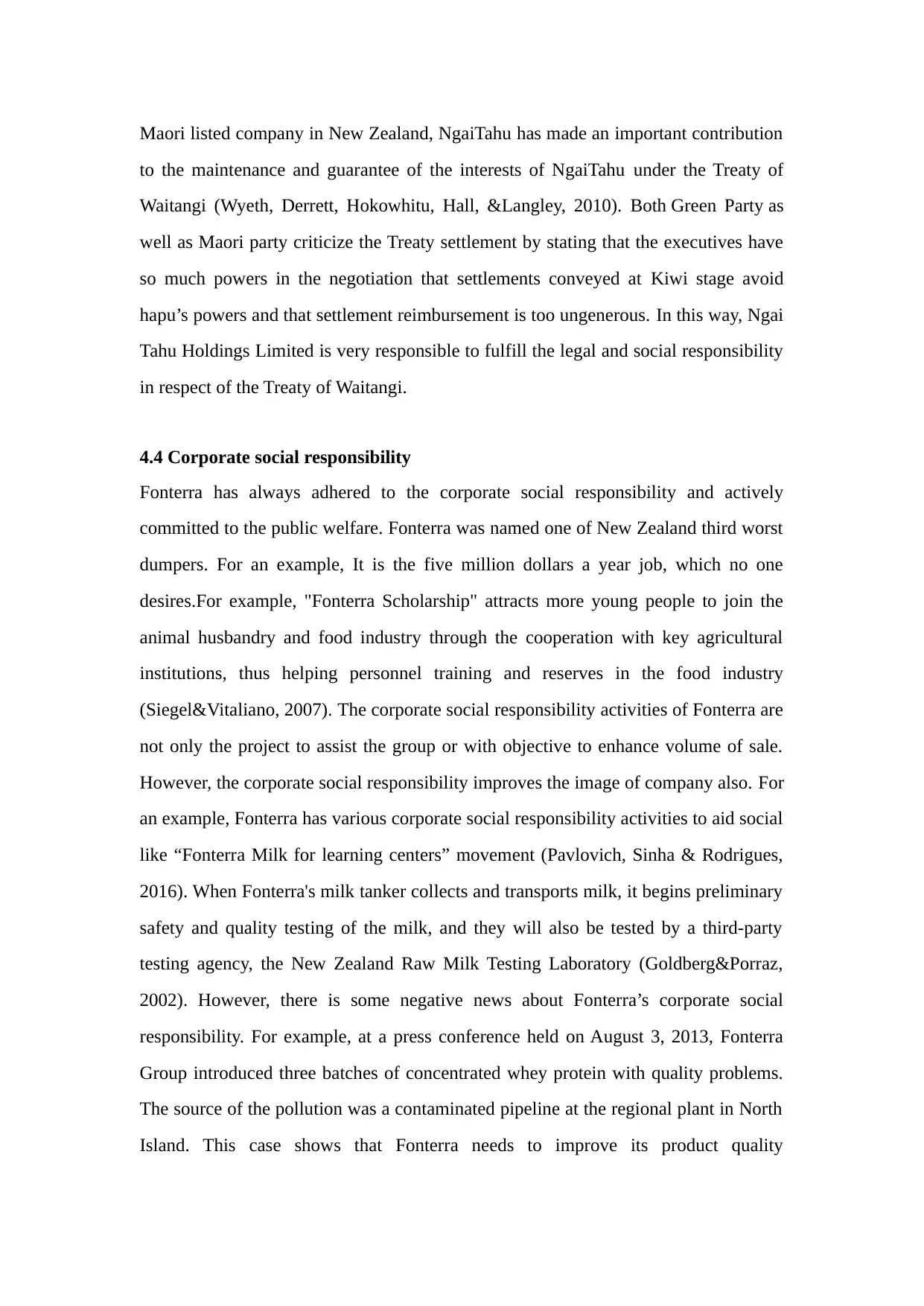
Maori listed company in New Zealand, NgaiTahu has made an important contribution
to the maintenance and guarantee of the interests of NgaiTahu under the Treaty of
Waitangi (Wyeth, Derrett, Hokowhitu, Hall, &Langley, 2010). Both Green Party as
well as Maori party criticize the Treaty settlement by stating that the executives have
so much powers in the negotiation that settlements conveyed at Kiwi stage avoid
hapu’s powers and that settlement reimbursement is too ungenerous. In this way, Ngai
Tahu Holdings Limited is very responsible to fulfill the legal and social responsibility
in respect of the Treaty of Waitangi.
4.4 Corporate social responsibility
Fonterra has always adhered to the corporate social responsibility and actively
committed to the public welfare. Fonterra was named one of New Zealand third worst
dumpers. For an example, It is the five million dollars a year job, which no one
desires.For example, "Fonterra Scholarship" attracts more young people to join the
animal husbandry and food industry through the cooperation with key agricultural
institutions, thus helping personnel training and reserves in the food industry
(Siegel&Vitaliano, 2007). The corporate social responsibility activities of Fonterra are
not only the project to assist the group or with objective to enhance volume of sale.
However, the corporate social responsibility improves the image of company also. For
an example, Fonterra has various corporate social responsibility activities to aid social
like “Fonterra Milk for learning centers” movement (Pavlovich, Sinha & Rodrigues,
2016). When Fonterra's milk tanker collects and transports milk, it begins preliminary
safety and quality testing of the milk, and they will also be tested by a third-party
testing agency, the New Zealand Raw Milk Testing Laboratory (Goldberg&Porraz,
2002). However, there is some negative news about Fonterra’s corporate social
responsibility. For example, at a press conference held on August 3, 2013, Fonterra
Group introduced three batches of concentrated whey protein with quality problems.
The source of the pollution was a contaminated pipeline at the regional plant in North
Island. This case shows that Fonterra needs to improve its product quality
to the maintenance and guarantee of the interests of NgaiTahu under the Treaty of
Waitangi (Wyeth, Derrett, Hokowhitu, Hall, &Langley, 2010). Both Green Party as
well as Maori party criticize the Treaty settlement by stating that the executives have
so much powers in the negotiation that settlements conveyed at Kiwi stage avoid
hapu’s powers and that settlement reimbursement is too ungenerous. In this way, Ngai
Tahu Holdings Limited is very responsible to fulfill the legal and social responsibility
in respect of the Treaty of Waitangi.
4.4 Corporate social responsibility
Fonterra has always adhered to the corporate social responsibility and actively
committed to the public welfare. Fonterra was named one of New Zealand third worst
dumpers. For an example, It is the five million dollars a year job, which no one
desires.For example, "Fonterra Scholarship" attracts more young people to join the
animal husbandry and food industry through the cooperation with key agricultural
institutions, thus helping personnel training and reserves in the food industry
(Siegel&Vitaliano, 2007). The corporate social responsibility activities of Fonterra are
not only the project to assist the group or with objective to enhance volume of sale.
However, the corporate social responsibility improves the image of company also. For
an example, Fonterra has various corporate social responsibility activities to aid social
like “Fonterra Milk for learning centers” movement (Pavlovich, Sinha & Rodrigues,
2016). When Fonterra's milk tanker collects and transports milk, it begins preliminary
safety and quality testing of the milk, and they will also be tested by a third-party
testing agency, the New Zealand Raw Milk Testing Laboratory (Goldberg&Porraz,
2002). However, there is some negative news about Fonterra’s corporate social
responsibility. For example, at a press conference held on August 3, 2013, Fonterra
Group introduced three batches of concentrated whey protein with quality problems.
The source of the pollution was a contaminated pipeline at the regional plant in North
Island. This case shows that Fonterra needs to improve its product quality
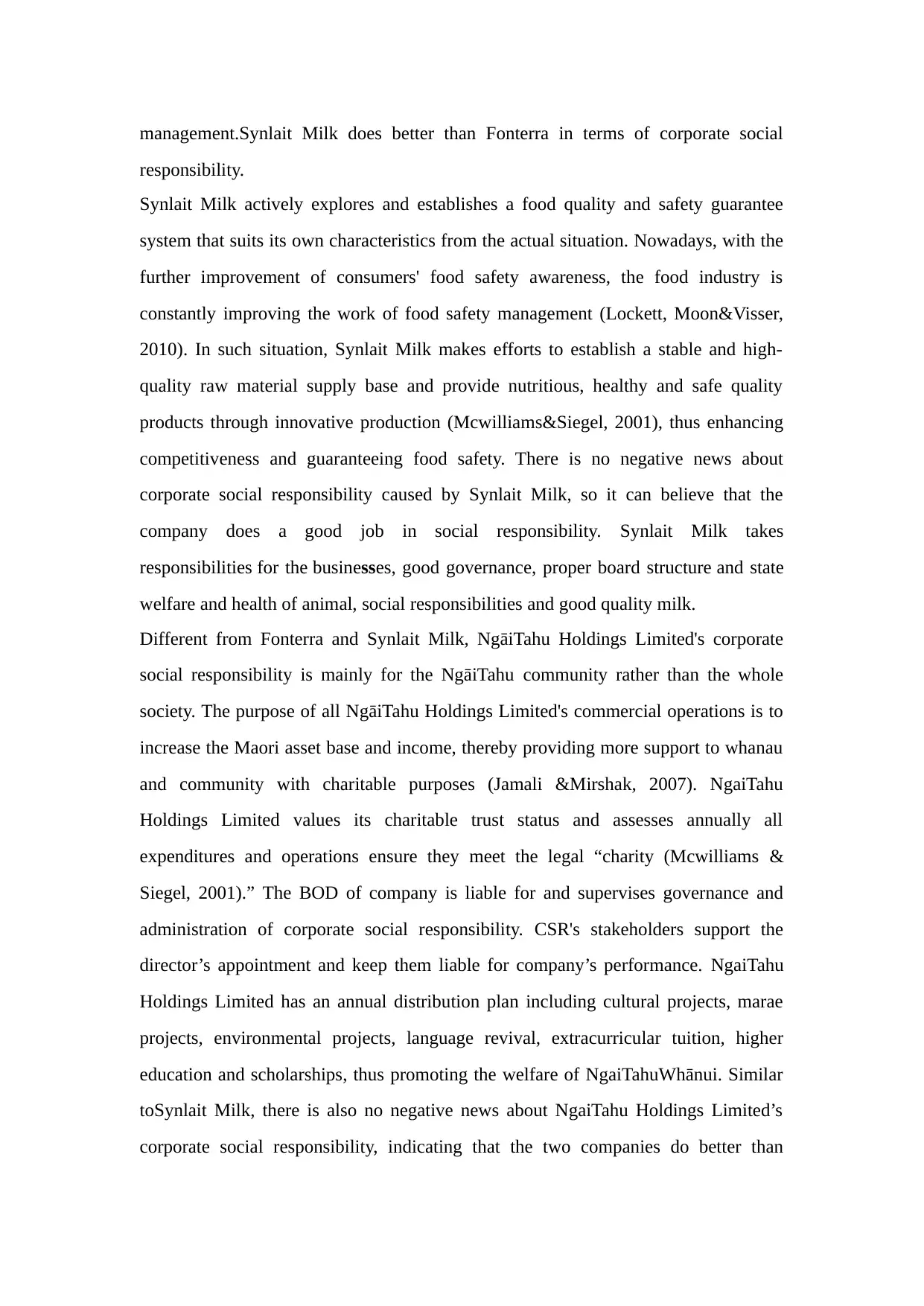
management.Synlait Milk does better than Fonterra in terms of corporate social
responsibility.
Synlait Milk actively explores and establishes a food quality and safety guarantee
system that suits its own characteristics from the actual situation. Nowadays, with the
further improvement of consumers' food safety awareness, the food industry is
constantly improving the work of food safety management (Lockett, Moon&Visser,
2010). In such situation, Synlait Milk makes efforts to establish a stable and high-
quality raw material supply base and provide nutritious, healthy and safe quality
products through innovative production (Mcwilliams&Siegel, 2001), thus enhancing
competitiveness and guaranteeing food safety. There is no negative news about
corporate social responsibility caused by Synlait Milk, so it can believe that the
company does a good job in social responsibility. Synlait Milk takes
responsibilities for the businesses, good governance, proper board structure and state
welfare and health of animal, social responsibilities and good quality milk.
Different from Fonterra and Synlait Milk, NgāiTahu Holdings Limited's corporate
social responsibility is mainly for the NgāiTahu community rather than the whole
society. The purpose of all NgāiTahu Holdings Limited's commercial operations is to
increase the Maori asset base and income, thereby providing more support to whanau
and community with charitable purposes (Jamali &Mirshak, 2007). NgaiTahu
Holdings Limited values its charitable trust status and assesses annually all
expenditures and operations ensure they meet the legal “charity (Mcwilliams &
Siegel, 2001).” The BOD of company is liable for and supervises governance and
administration of corporate social responsibility. CSR's stakeholders support the
director’s appointment and keep them liable for company’s performance. NgaiTahu
Holdings Limited has an annual distribution plan including cultural projects, marae
projects, environmental projects, language revival, extracurricular tuition, higher
education and scholarships, thus promoting the welfare of NgaiTahuWhānui. Similar
toSynlait Milk, there is also no negative news about NgaiTahu Holdings Limited’s
corporate social responsibility, indicating that the two companies do better than
responsibility.
Synlait Milk actively explores and establishes a food quality and safety guarantee
system that suits its own characteristics from the actual situation. Nowadays, with the
further improvement of consumers' food safety awareness, the food industry is
constantly improving the work of food safety management (Lockett, Moon&Visser,
2010). In such situation, Synlait Milk makes efforts to establish a stable and high-
quality raw material supply base and provide nutritious, healthy and safe quality
products through innovative production (Mcwilliams&Siegel, 2001), thus enhancing
competitiveness and guaranteeing food safety. There is no negative news about
corporate social responsibility caused by Synlait Milk, so it can believe that the
company does a good job in social responsibility. Synlait Milk takes
responsibilities for the businesses, good governance, proper board structure and state
welfare and health of animal, social responsibilities and good quality milk.
Different from Fonterra and Synlait Milk, NgāiTahu Holdings Limited's corporate
social responsibility is mainly for the NgāiTahu community rather than the whole
society. The purpose of all NgāiTahu Holdings Limited's commercial operations is to
increase the Maori asset base and income, thereby providing more support to whanau
and community with charitable purposes (Jamali &Mirshak, 2007). NgaiTahu
Holdings Limited values its charitable trust status and assesses annually all
expenditures and operations ensure they meet the legal “charity (Mcwilliams &
Siegel, 2001).” The BOD of company is liable for and supervises governance and
administration of corporate social responsibility. CSR's stakeholders support the
director’s appointment and keep them liable for company’s performance. NgaiTahu
Holdings Limited has an annual distribution plan including cultural projects, marae
projects, environmental projects, language revival, extracurricular tuition, higher
education and scholarships, thus promoting the welfare of NgaiTahuWhānui. Similar
toSynlait Milk, there is also no negative news about NgaiTahu Holdings Limited’s
corporate social responsibility, indicating that the two companies do better than
⊘ This is a preview!⊘
Do you want full access?
Subscribe today to unlock all pages.

Trusted by 1+ million students worldwide
1 out of 24
Your All-in-One AI-Powered Toolkit for Academic Success.
+13062052269
info@desklib.com
Available 24*7 on WhatsApp / Email
![[object Object]](/_next/static/media/star-bottom.7253800d.svg)
Unlock your academic potential
Copyright © 2020–2025 A2Z Services. All Rights Reserved. Developed and managed by ZUCOL.

